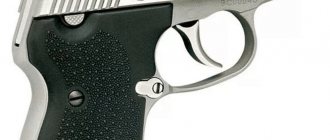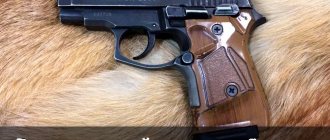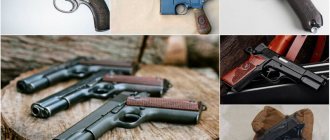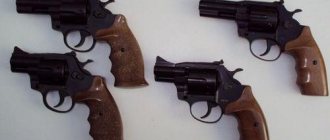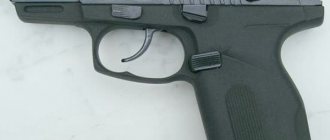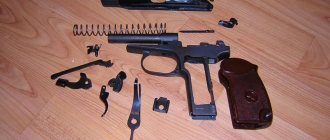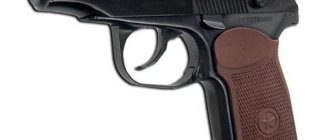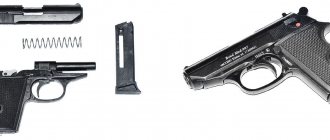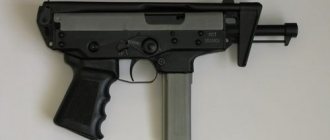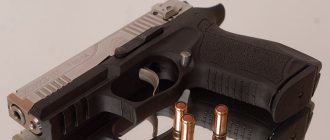The first guns required two or three people to operate. The desire to have a powerful argument in any situation literally “at hand” first led to the appearance of the guns we are familiar with, which could be carried over the shoulder. Then the cavalrymen adapted shortened guns to the saddle. Then they shortened it a little more... And that’s how the first pistols appeared.
A serious race has begun for compactness and rate of fire. In the era of breech-loading weapons, very short multi-barreled pistols - “pepperboxes” (piperboxes) - were popular for a long time. Their ultra-compact version had only two barrels, but it literally fit into a suit pocket and gave the owner a very good chance to say his last word in an unexpected dispute.
This is how the famous “derringers” (named after the American gunsmith who made capital on a successful design) appeared - double-barreled “last chance pistols”. (It was the “derringer” in the third part of “Back to the Future” that “Mad Dog Tannen” used as an argument).
The advent of unitary cartridges made it possible to increase the ammunition capacity without increasing the thickness of the pistol. At first, flat magazines held only five or six rounds - but such weapons were unusually flat compared to similar pistols of the revolving system. Today, the “fierce little ones” are almost as good as their older brothers in terms of power and magazine capacity.
Here are the 10 smallest handguns you can shoot in the world.
Taurus Curve
dimensions: 94x30x131 mm
The Taurus Curve self-loading pistol is an innovative development of the Taurus company. Thanks to its special patented shape that follows the curves of the human body, Taurus Curve is ideal for concealed carry. The pistol, made of special polymers, has no protruding parts, and all its corners are rounded. A holster is not necessary for the Taurus Curve, as it attaches nicely to your belt using a regular belt clip. The pistol also has its drawbacks in the form of the absence of a safety lock and a trigger delay lever.
Vesta
Vesta
The laurels of the Belgian Browning of 1906 haunted the Spanish developers, and the result was one of the copycat models of such a famous pocket weapon - the Vesta pistol:
- caliber 6.35 or 7.65mm;
- magazine capacity – 6 rounds;
- auto.
In the ladies' pistol of the Spanish brand Vesta, the safety is located in the middle above the trigger, but otherwise it is very similar to the 1906 Browning.
West’s models are of the “Eibar” type (named after the Spanish city of Eibar, the famous arms capital of the early twentieth century).
Read the article about the names of pistols.
The Spanish ladies' pistol comes in other brands: Astra, Star. These are usually modern models. For example, Astra A-60 (model 1987):
| Weight | 720 g |
| Trunk | 89 millimeters |
| total length | 168 millimeters |
| Caliber | 9 (short), 7.65 |
| USM | double acting |
| In the shop | 12 rounds, staggered |
A ladies' pistol, the price of which largely depends on its type, brand, year of manufacture, country of origin, for a long time was only a product of foreign manufacturers. But since the 70s of the 20th century, domestic small-sized weapons began to be produced.
The Tula creative group developed the PSM pistol (small-sized self-loading pistol), distinguished by:
- thinness (the thickness was only 17 millimeters - about the size of a matchbox);
- absence of protruding parts on the side surfaces;
- reliable automation;
- the ability to quickly open fire from a combat platoon with the weapon on;
- caliber 5.45;
- Firing range – 50 meters.
An article about repairing IZH 53m will be useful.
P08 Luger
dimensions: 135x40x217 mm
The first pistol with the name “Pistole Parabellum P.08” was adopted as a standard model of short-barreled weapons of the German army on August 22, 1908. In 1911, the need for personal weapons increased so much that the model was put on the assembly line on a national scale. The P.08 was also actively exported abroad, where it earned a reputation as an excellent weapon for defense and attack. Today, individual gunsmiths continue to work with luggers, trying to improve them.
Sig Sauer P290
dimensions: 99x28x140 mm
The compact Sig Sauer P290 pistol can be used as a concealed carry weapon by both police officers and ordinary citizens. It can act as the main weapon or as a backup option. The frame of the Sig Sauer P290 is made of impact-resistant polymer, and the slide-casing is made of stainless steel. The pistol, however, can hardly be called comfortable, but it is miniature and functional.
general information
These pistols are also called parlor pistols, vest pistols, or pocket pistols, but, in fact, they are full-fledged small-sized weapons that are intended for concealed carry. Many people know what a pistol looks like, but few know about its types.
It is often used by intelligence agencies as a “weapon of last chance” and is carried concealed (on the ankle, in the sleeve, etc.). Most pistols chambered in .25ACP are considered pocket pistols.
The main differences between “ladies’” weapons:
- ease;
- compactness;
- ease of use;
- small caliber (less recoil);
- good power to hit at close range.
Such pistols first appeared in the 19th century. Modern women's pistols in the world are very diverse.
The derringer-type pistol can be considered the ancestor of women's weapons (the name is given by the name of the creator of small capsule pistols, G. Deringer).
This pocket pistol appeared in America at the beginning of the 19th century and gained great popularity not only in the USA, but also in Europe.
This video reviews the Derringer pocket pistol.
“Derringers” combine portability and high power, simplicity and reliability. Because of their short trunks, they were nicknamed “bulldogs.” Currently, Russian intelligence and special services are armed with a silent version of the derringer. The material about which air pistol is the most powerful of the permitted ones will be very useful.
Ruger LCP
dimensions: 91x20x131 mm
The Ruger LCP semi-automatic subcompact is a popular concealed carry weapon in the United States. The gun is made from high-quality alloy steel and fiberglass-reinforced polymer. The model has several options for finishing and coloring the frame. There are also special versions with an exquisitely engraved bolt.
NAA Guardian.380 from Colt
dimensions: 90x24x121 mm
NAA Guardian.380 from Colt belongs to the category of so-called reserve pistols for American police. The model owes its popularity to its low weight, miniature size, and, of course, reliability. The NAA Guardian.380 is especially effective at a distance of up to 5 meters and has, as is customary with Colt, many modifications.
Derringer DA 38
length: 122 mm
The Derringer DA 38 is still considered one of the best pistols for self-defense. The name of the pistol comes from the name of the American gunsmith Henry Derringer, who designed the first model in the nineteenth century. The first Philadelphia "derringer" was compact, reliable and affordable. He was in great demand among card players, women of easy virtue, merchants, travelers and adventurers. These days, the Derringer DA 38 has found its fans in the police ranks. The innocuous appearance of the Derringer DA 38 is very deceptive. The mini-pistol has recoil that can dislocate the shoulder of an untrained person.
OTs-21 "Baby"
dimensions: 100x20x126 mm
The small-sized Russian-made self-loading pistol OTs-21 “Malysh” was developed in the mid-90s at TsKIB SOO by designer Yuri Ivanovich Berezin. Externally, the pistol is very similar to the NAA Guardian.380 and is suitable for carrying in a trouser pocket, jacket or handbag. Although the weapon does not have a safety lock, the manufacturer guarantees safe use to the owner. “Malysh” also has some disadvantages. Thus, weapon experts complain about poor shooting accuracy and the magazine being limited to 5 rounds.
Less palm
The small-sized PSM pistol, created in the USSR, has long been the standard and the only mass-produced model of domestic concealed carry weapons. Only in the 90s did Russian weapons design bureaus begin to develop various compact pistols for service and combat purposes.
Adults "Kids"
The history of the new Russian small-sized pistol, which began in January 1994, almost exactly repeated the first steps of its predecessor PSM. The Ministry of Internal Affairs was again the first to become interested in this weapon, and the development of the pistol was again entrusted to the Tula Central Design Research Bureau of Sporting and Hunting Weapons (TsKIBSOO). This time it was decided not to invent a new lethal complex, but to use the standard 9x18 mm cartridge. This option made it possible to get rid of several disadvantages inherent in the PSM complex, such as the low stopping effect of the bullet, as well as the rarity of the 5.45x18 mm cartridge and its small reserves.
Soon, a small-sized pistol with the index OTs-21 appeared in TsKIBSOO. The Tula “Baby” turned out to be almost 3 cm shorter than its Soviet older brother, but a little thicker. With a 5-round magazine without a protruding heel, the overall height of the pistol was 87.5 mm. An ergonomic magazine with a rest for the little finger and a more comfortable hold in the hand increased the height of the weapon to 100 mm, almost equaling the PSM in this indicator. The developers also intended, if necessary, to produce magazines of increased capacity for 8 and 10 rounds, but even with such dimensions, the OTs-21 fit well in the palm of any average user.
Pistol OTs-21 kalashnikov.media
To achieve the minimum dimensions of the weapon, the pistol has sights that do not protrude beyond the dimensions of the bolt and a semi-hidden trigger. The front sight is recessed into a shallow groove along the entire upper edge of the bolt, and the rear sight slot is also recessed inside it. In addition, the “Baby” does not have an open protruding fuse. The safety of using a loaded pistol is ensured only by a self-cocking trigger mechanism (USM) and a fairly high trigger pull force (about 7 kg). The magazine release is also hidden at the bottom of the pistol grip.
As a result, the Tula residents got a very successful “Baby” with a declared accuracy of 12 cm in diameter at a distance of 10 m. The OTs-21 complex with the 7N25 armor-piercing cartridge proposed for law enforcement agencies ensures penetration of class 2 body armor or a 4-mm steel plate at distance of 5 m. For security structures, “Malysh” has a service version OTs-21S chambered for 9x17 mm. There is an even more miniature and rare version of the Tula “Malysh” (with the index OTs-26) chambered for 5.45x18.
Pistols OTs-21 (left) and OTs-26 Magazine "Weapons"
Pistol designer Yu.I. Berezin managed to successfully create one of the smallest domestic pistols. The OTs-21 was adopted by the Ministry of Internal Affairs in 2001, and in 2006 the OTs-21 and OTs-26 entered service with prosecutors and investigators. Also, since 2005, 5.45 mm and 9 mm “Kids” have been included in the list of award weapons for citizens of the Russian Federation, and from 2022 they can also be awarded to foreign citizens. OTs-21 pistols are produced by the Tula TsKIBSOO at a rate of several hundred units per year, but are very rarely shown to the general public.
Russian deringer
In the 90s, the topic of small-sized pistols did not pass over other Russian arms enterprises. In 1998, designers from Zlatoust tried to take the first steps in this specific field of small arms. At the Moscow International Arms Exhibition, at the stand of the Zlatoust Machine-Building Plant (ZMZ), two samples of experimental small-sized pistols chambered for 9x17 mm were demonstrated.
The first of them - PSK - turned out to be not much smaller than the PM, and did not attract much attention, apart from the presence of a mechanical safety on the back of the pistol grip. The second, called “Pygmy,” seemed a more interesting model, representing a deringer with a folding block of two barrels. However, experiments with small-sized pistols in Zlatoust stopped there.
Pistols PSK (left) and “Pygmy” Magazine “Armory Yard”
A little earlier, in 1996, the Izhevsk Mechanical Plant (Izhmekh) presented its deringer. The MP-451 pistol had a classic design for this class of weapon and stood out only in that it was one of the first in the modern history of Russia. In terms of dimensions, the MP-451 is practically the same as the Tula “Baby”, but can fire only two quick shots. The accuracy of the deringer's fire at a distance of 10 m is 20 cm in diameter, which is almost twice as bad as that of the OTs-21S. At the same time, the MP-451 had a good chance of becoming a weapon of self-defense for the civilian population when using a cartridge permitted for this purpose by law.
Subsequently, the design of the Izhevsk deringer was improved in terms of increasing the safety of use by a wide range of consumers. The MP-451 pistol received a barrel locking lever, combined with a safety lock, and a function for extending the trigger when cocking the hammer. However, the pistol was not widely used, although it was included in the cadastre of service weapons in Kazakhstan.
Pistol MP-451 Magazine "Armory Yard"
Lost "Khortitsa"
Attempts to develop pistols with minimal overall dimensions were also made in neighboring Ukraine. At the end of the 90s, a whole family of Khortytsya pistols was born in a design bureau specially created for these purposes in Zaporozhye. The first was the small-sized model “Khortitsa-76” chambered for a small-caliber rimfire cartridge, but in the “Khortitsa-76M” version a version chambered for the 5.45x18 mm MPTs cartridge was planned.
The main combat version of the Zaporozhye pistol chambered for 9x18 mm was designated “Khortitsa-125” and had not so modest dimensions. With an impressive barrel of 125 mm, such a weapon occupied an intermediate position in length between the PM and APS. But the thickness of the Khortytsya pistol (20 mm) could compete even with the PSM. Ukrainian engineers intended to create a powerful military weapon with the ability to be carried concealed. There was a version with a safety lock on the trigger and only a self-cocking version. Later, “Khortytsya” in the version for the 9x19 mm cartridge became a little larger and “fat,” allowing modification for powerful .357 Magnum ammunition.
Pistols “Khortitsa-76” and “Khortitsa-125” Magazine “Weapons and Hunting”
Such an interesting and original project never made it to testing and trial operation in law enforcement agencies, and further funding ceased. Everyone forgot about Khortitsa, remembering it ten years later only in the wake of the scandal - the creators of the weapon and the management of the enterprise were accused of illegally producing firearms.
Vasiliev pistol
In Belarus, over the past few years, they have actively engaged in the production and design of small arms. Lacking their own specialists and traditions of a weapons school, Belarusians attract Russian specialists for these purposes. I.M. was appointed the main designer of pistols in the Belarusian. Vasilyeva. At the Milex-2017 exhibition, the Russian engineer presented his version of the small-sized concealed carry pistol PSNV.
PSNV pistol tut.by
The task was to develop a pistol in the dimensions of the PSM, but chambered for a 9-mm cartridge. Considering the significant increase in caliber, Vasiliev practically managed to catch up with the timeless Soviet classics, which are still used by law enforcement operatives. It was even announced that the pistol had a record thickness of 18 mm. It turned out that this parameter corresponds to the width of the shutter and frame, and it can only be achieved in a self-cocking semi-automatic version. Taking into account the pistol grip lining, bolt stop and safety, the width of the PSNV was 20 mm.
The pistol as presented turned out to be 10 mm longer than the PSM due to the long barrel protruding beyond the edge of the bolt, which allows the attachment of sound suppression devices. By replacing the barrel, mainspring and magazine, the cartridge used is changed from 9x18 mm to 9x17 or 9x19 mm. In the latest version, the PSNV pistol claims to be one of the most compact self-loading pistols. The weapon is still at the development and development stage, which means tests and possible changes in the design are ahead.
Shooting from PSNV VPK-Belarus
Compacts and subcompacts
One of the newest versions of small-sized weapons was the Izhevsk MP-443 pistol, presented by the Kalashnikov concern at the Army-2017 weapons forum. This pistol is a modern version of a long-standing development within the framework of the Bars R&D project, introduced in the mid-2000s. The design of this product is not original and copies the design of a Makarov pistol, but in a reduced form. At the same time, a rubber-fired version of the MP-357 pistol was also presented, which has every chance of attracting the interest of potential users.
Today, designers are increasingly turning to the design of special models of small-sized weapons, preferring the creation of compact and sub-compact versions of full-size pistols. So, quite recently, the same Kalashnikov concern presented a modernized version of the Yarygin army pistol under the designation MPYA. Among the promising samples presented in 2018, there was also a compact version of the MP.
Compact version of the MPYa pistol Lazarev K.
Another Izhevsk development within the framework of the Cayman R&D project, which has been trying to win its place in the sun for more than five years, has managed to acquire the third generation of development of the design of engineer Lebedev. First, in 2014, the PL-14 pistol appeared, which a year later received an updated version of the PL-15. The 2015 version also included a compact version of the PL-15K in its model range. The compact version of the Lebedev pistol has a striker-type trigger (as opposed to a hammer-type trigger in the PY) and with almost equal dimensions, it is 10 mm thinner. It was the compact version of the pistol that security forces showed the greatest interest in. In 2022, Izhevsk designers presented the modernized Lebedev pistols MPL-1 and MPL-2, which probably tried to compete with the Klimov “Boas” 6P72 and 6P72-1. However, it is not yet clear whether compact versions of the MPL will appear.
Comparison of PL-15 and PL-15K pistols (left) Popular Mechanics magazine
Despite the fact that the “Boas” have not yet acquired their own compact versions, their closest “snake” relatives chambered for 9x19 mm are already following this path.
As part of the Poloz and Aspid R&D projects in Russia, compact versions of sports and tactical pistols are being developed under the designations RG120-2 and RG120-3. Pistol characteristics
| Name | PSM | OTs-26 | MP-451 | OTs-21 | MP-443 | PSNV | PL-15K |
| Regular cartridge | 5,45×18 | 5,45×18 | 9×17 | 9×18 | 9×18 | 9×18 | 9×19 |
| Weight with empty magazine, g | 460 | 400 | 350 | 600 | 640 | 420 | 720 |
| Length, mm | 155 | 115 | 130 | 127 | 148 | 165 | 180 |
| Height, mm | 106 | 92 | 97 | 100 | 105 | 100 | 131 |
| Width, mm | 17 | 19 | 25 | 21 | 20 | 20 | 28 |
| Magazine capacity, cartridges | 8 | 5 | 2 | 5 | 6 | 6 | 14 |
| Barrel length, mm | 85 | 60 | 60 | 64 | n/a | 90 | 92 |
Sources and literature:
- Small-sized self-loading pistol chambered for the 9 mm pistol cartridge OTs-21. Passport OTs-21 PS
- Russian melee weapons. Almanac. M.: “LSOP”, 2010
- Hooke R. Plans. Goals. Three trunks. How the first Belarusian pistols were created. Spetsnaz magazine, No. 132 January/February 2019
Double Tap
dimensions: 99x17x130 mm
Double Tap is a pocket pistol for self-defense from Heizer Defense. It is made of the “derringer” type and has two vertically located trunks. Double Tap is available in two versions - with an alloy frame and titanium frame. The edges of the gun are smoothed and there are no protruding parts. You can easily carry it even in your jeans pocket. A distinctive feature of the Double Tap is the ability to store two spare rounds in its grip.
Advantages and disadvantages of compact traumatic pistols
There are different modifications of traumatism. Some people like large weapons, while others are attracted by compactness. Small-sized weapons have the main indicators of practicality: budget price, ability to be worn under clothing, lack of complex mechanisms. To understand what is bad and what is good about a small traumatic pistol, you should study the pros and cons of the device:
Advantages and disadvantages
Compactness. Can fit in a jacket pocket
Easy to disassemble. A model with a complex mechanism is rare
Budget cost. Compact devices are much cheaper
Amenable to repairs that can be carried out by a person without special skills
Mediocre power, although there are models that refute this
Most compact devices have a high accuracy rate
The strength of the parts is not high. Most minor injuries have plastic parts
Tuning and upgrades are problematic. Most small-sized traumatizers have plastic parts, which eliminates rework
Not every small injury can boast high power, and this is its main drawback.
Franz Pfannl Erika 1912
dimensions: 85x19x116 mm
This pistol is a historical exhibit and a hunting object for weapon collectors. The model was developed by gunsmith Franz Pfannl, who initially positioned it as an ideal pocket weapon. Outwardly, Franz Pfannl Erika 1912 seems very uncomfortable, but this impression is very deceptive. The compact pistol fits comfortably in the hand, holds securely, and all controls are easily accessible. An interesting feature of the Franz Pfannl Erika 1912 is the fuse. It is easy to remove with a foreign object, which is a significant disadvantage of the model. At the same time, the presence of an ambidextrous lever makes it one of the first pistols adapted for shooting from both the right and left hands.
Seecamp LWS 32 Auto
dimensions: 51x17x108 mm
The Seecamp LWS 32 Auto prototype with a 6.35 mm caliber was developed and patented in the 70s of the last century by the young talented gunsmith Larry Seecamp. In 1985, production of the model was discontinued. After that, up to the present time, a model with a caliber of 7.65 mm is produced. A distinctive feature of the Seecamp LWS 32 Auto is the exclusive use of cartridges with hollow-point bullets. Conventional cartridges with a jacketed bullet simply do not fit into the magazine. As soon as it went on sale, Seecamp LWS 32 Auto immediately became wildly popular in the USA. Of course, this “baby” is quite capable of taking a person’s life.
Walter
Walter
The German armory was founded in 1886, but began producing pocket pistols only in 1911. The product turned out to be very successful and glorified the company: by the mid-thirties of the 20th century, Karl Walter became one of the world's largest suppliers of personal weapons.
Walter produced five main models of pocket pistols. The very first of them contributed to the rise and prosperity of the company. It was not just a copy of the 1906 Browning, but a creative development: light and compact, with a six-round magazine of 6.35 mm caliber, an open bolt-casing, and a percussion-type blowback mechanism.
The second model was simpler, it used a hidden trigger, and the rear sight was also an indicator of the presence of a cartridge in the chamber; this model was patented in 1913.
Model No. 3 is a rarity, as only 3,500 were produced from 1913 before production ceased. The caliber here was larger - 7.65 mm, and there was a side window for ejecting cartridges at the top left of the bolt casing, which was not particularly convenient for shooting (the ejected cartridge fell into the shooter’s field of view).
The fourth model was an eight-shot analogue of the third, only with an enlarged barrel and simplified disassembly. It was intended mainly to equip the police, but production ceased in 1923.
The fifth model is an improved second with a reduction in the barrel bore to four rifling and a fixed rear sight.
At the end of World War II, the plant was destroyed, the archives were looted or destroyed. The resumption of production became possible only in the 50s of the 20th century, and by 1960 “Walter” was again leading in the creation of the best examples of personal weapons, combining tradition with new developments.
See also the material about the German Walter pistol.
Main technical characteristics of police officer Walter:
| Trigger mechanism | double acting |
| Gun | self-loading |
| Eat | later shortened version |
| Weight | 682 g |
| Length | 170 mm |
| Valid | based on the blowback recoil principle |
| Eight-shot | at 7.65×17 mm |
| Maximum range | 25 meters |
Fans will appreciate the air-powered Colt 1911.
Read about IZH Makarov pneumatics here.
See also PKSK submachine gun Kedr at:
Pistol "Kolibri"
length: 65 mm
Another development of the Austrian gunsmith Franz Pfannl. The miniature Kolibri automatic pistol was positioned as a weapon for self-defense, but its low destructive power prevented it from becoming popular. This minivan can only penetrate the leather jacket of an attacker. Ultimately, in 1938, serial production of Kolibri was discontinued. The undeniable advantages of the model are its filigree processing, ease of handling and small size. Nowadays, the Kolibri pistol is of interest exclusively to collectors and connoisseurs of rare weapons.
SwissMiniGun
dimensions: 35x10x55 mm
The SwissMiniGun was created by a team of top-notch Swiss craftsmen based on the mechanical functions and appearance of the Colt Python .357 Magnum revolver. The result was, surprisingly, a small, working revolver that looked more like a key fob than a firearm. But this little one has a firing range of 112 meters and hits without a miss. The pistol was included in the Guinness Book of Records as the smallest revolver in the world. SwissMiniGun is also available in an elite version made of pure gold and encrusted with diamonds. The price of such a work of art starts at $50,000.
Examples[edit]
Literature[edit]
- “Neuromancer” by W. Gibson is the pistol of Case, the main character of the book: an old Vietnamese counterfeit of a Brazilian copy of the “Walther PPK” chambered for .22 LR caliber (small 5.6 mm).
- "Repairman Jack" by F. Paul Wilson - Jack originally carried a Summerling pistol in a holster strapped to his ankle - a real-life non-automatic pistol with a four-round magazine of .45 caliber (a fifth cartridge can be carried chambered). This "Semmerling" saved Jack's life several times - but the police almost used it to identify Jack, since the pistol is still quite rare.
- “Spy Novel” by B. Akunin - a writing pen-pistol serves as an argument for Wasser ( Englishman
) that he was sent by the Fuhrer to negotiate with the leader of the Soviet people, and not to kill him: Wasser demonstratively misses. - longer
handguns in the setting , but there are pocket spring crossbows in the form of a tube with a handle.
Due to the tight cocking, this is strictly a single-shot weapon, but it is easy to hide - and anyone who gets caught with such a crossbow in Ankh-Morpork, Commander Vimes will clearly show exactly where
it can be hidden. And let them be glad that they didn’t get caught by the Assassin Guild, they would have pulled the trigger.
Music[edit]
- “The King and the Clown” - “Funny Pistol”: the lyrical hero of this song reveals to the girl he deceived that he confessed his love to her not because of feelings, but because of a bet, after which she “surprises” him with a lady’s pistol suddenly appearing in her hand : Judging by the abrupt ending, the surprise turned out to be fatal.
Cinema[edit]
- In Django Unchained, bounty hunter Schultz carries a small double-barreled Remington Derringer in his sleeve, which jumps out into his hand thanks to a scissor mechanism. Using this weapon, Schultz unexpectedly kills slave trader Calvin Candy.
- "Men in Black" - "ladies' cricket" that Agent Kay gives Jay. The joke version of the trope is that the recoil of this tiny pistol is stronger than that of large guns, and the shot is quite destructive.
- Back to the Future - Emmett Brown. Shot in the back by Bifford Tannen over $80." Marty McFly's attempt to save his friend, who ended up in 1885, was almost thwarted due to the fact that Tannen attacked Dr. Brown before the date indicated on the tombstone - he secretly smuggled a tiny pistol into the carnival. According to the villain, “the last person he killed took two days to die.”
- “For a Few Dollars More,” a pocket Derringer hidden in his sleeve is successfully used by Colonel Douglas Mortimer during a duel in a tavern in the town of Acqua Caliente with the Hunchback, a member of the El Indio gang.
- "State Councilor" - Prince Pozharsky uses a hidden pocket Browning to outwit Green, who had him at gunpoint. According to him, “this wonderful little thing is saving his life for the third time.” However, he still did not live long after that.
- “Spy” is both a free (in terms of setting) and detailed (in terms of the chronology of events) film adaptation of “The Spy Novel”: Wasser ( Kogan
) shoots at the balcony fence while talking with Asian.
Anime and manga[edit]
- Black Lagoon is Roberta's shooting buckle in the OVA, which she used to forever calm down a former FARC colleague who tried to rape her.
- “Trigan” - insurance agent Meryl Strife hides several dozen “derringers” under her white cloak, from which she famously shoots in Macedonian style.
Video games[edit]
- Deus Ex is a single-shot and disposable PS20 plasma pistol. Useless toy.
- Fallout: New Vegas - the game has a mechanic for searching and handing over weapons when entering the casino, so pocket pistols (a short-nosed police revolver and a .22 pistol) have their advantage: they will not be taken away at the entrance.
- Fallout 4 is a unique pocket pistol with a silencer (which can be removed) Deliverer, of the Walter PPK breed, which can be obtained by completing the first quest of the Underground.
- HITMAN™ and HITMAN™ 2 - there is also such a weapon called Custom 5mm (“Special five-millimeter”). This is a very compact pistol with a built-in silencer that is undetectable during a search. In appearance it is somewhat similar to the Ideal Conceal pocket pistol, which when folded imitates a smartphone (and therefore undetectable during a search). All these advantages are balanced by one thing: this model uses caseless cartridges and there are only 5 of them. Unfortunately, this weapon does not allow reloading in the field, which means that with it the player will be limited to five shots for the entire mission.
- Red Dead Redemption 2 - Algernon's revolver. It is essentially a modified and scaled down Colt M1892 with a shorter barrel.
- "Access code: PARADISE" - "Ladies' man": an ultra-compact pistol, designed by a famous couturier. The smallest pistol in the game and a clear self-defense weapon, as indicated by the low damage and additional shock damage modifier.
Board games[edit]
- Star Wars d20 RPG - The rulebook includes a small Holdout Blaster that only does 1d4 damage, but is easy to hide.
- Warhammer 40,000 is a thimble weapon supplied primarily by Jokairo. Looks like a ring on a finger, but shoots like a full-fledged pistol or rifle. Unfortunately, the charge is only enough for one shot.
Real life[edit]
- In the 18th-19th centuries, pistols disguised as silverware and even large rings (a drum on the top side of the ring, a trigger in the form of a tiny pedal on the side of it) were in use among aristocratic circles. They couldn’t cause any real harm, but catching the attacker by surprise or clearly marking him in the wake of a miniature bullet—perhaps yes. The princes of the Church of the Holy Roman Empire had a pistol disguised as a Bible, which fired when the bookmark of the book was pulled.
- US President Abraham Lincoln lost his life because of a bullet fired by John Booth from a derringer. Moreover, this particular example of the Philadelphia Deringer brand pistol was made personally by Henry Deringer, the inventor and manufacturer of this type of weapon.
- “Le Protector” - “The Defender” (in the USA it was also known as the “Protector Revolver”), a patent by gunsmith-inventor Jacques Turbiaux for a “revolver” in which the cartridges were located radially in a cylindrical clip, due to the specific grip of the pistol and The trigger release lever is known as an “expander pistol”: it has an unusual disk shape 125 mm thick and 50 mm in diameter, to which the barrel is attached, lugs for easy holding in the hand, and a trigger lever located on the back side of the barrel. The pistol block held 7 rounds of 8 mm caliber or 10 rounds of 6 mm caliber, depending on the type of pistol. It was popular at the end of the 19th century as a means of self-defense because it could be placed in the fist, as well as in a jacket pocket, glasses case or handbag.
- “SS-Waffenakademie Koppelschloßpistole” (“SS Armed Forces Academy Belt Buckle”) is the invention of the gloomy Teutonic genius Louis Marcus, officially patented by him after his captivity in the First World War. In 1942, the SS leadership became interested and in 1943 it was presented to Heinrich Himmler personally, and he approved it for production, which began in 1944 at a bicycle factory in the city of Leibnitz, but, alas, was almost immediately destroyed by aircraft. It existed in two modifications: the first was a double-barrel design with a caliber of 7.65 mm, the second had four barrels with a caliber of 5.6 mm. There is no information about the combat use of the SS-Waffenakademie Koppelschloßpistole, in addition, the exact number of buckles produced is not known for certain, however, two pieces that are now in private collections have serial numbers 155 and 158.
